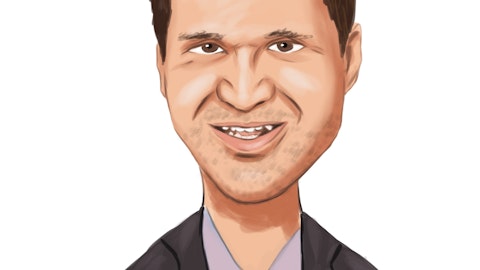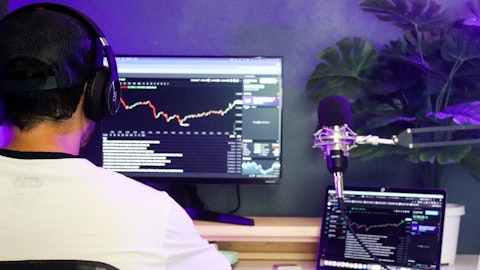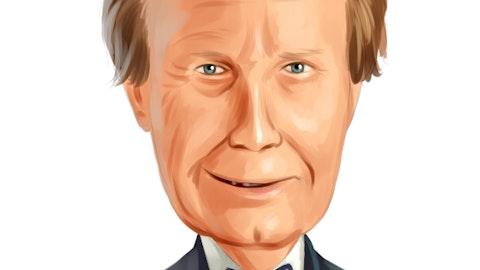Hudson Technologies, Inc. (NASDAQ:HDSN) Q4 2022 Earnings Call Transcript March 8, 2023
Operator: Good day everyone, and welcome to the Hudson Technologies’ Fourth Quarter 2022 Earnings Call. At this time, all participants have been placed on a listen-only mode and we will open the floor for your questions and comments after the presentation. It is now my pleasure to turn the floor over to your host, Jen Belodeau. Ma’am, the floor is yours.
Jen Belodeau: Thank you. Good evening and welcome to our conference call to discuss Hudson Technologies’ financial results for the fourth quarter and year ended 2022. On the call are Brian Coleman, President and Chief Executive Officer; and Nat Krishnamurti, CFO. I’ll now take a moment to read the Safe Harbor statement. During the course of this conference call, we will make certain forward-looking statements. All statements that address expectations, opinions or expectations about the future are forward-looking statements. Although they reflect our current expectations and are based on our best view of the industry and our businesses, as we see them today, they are not guarantees of future performance. Please understand that, these statements involve a number of risks and assumptions.
And since those elements can change and, in certain cases, are not within our control, we would ask that you consider and interpret them in that light. We urge you to review Hudson’s most recent Form 10-K and other subsequent SEC filings for a discussion of the principal risks and uncertainties that affect our business and our performance and of the factors that could cause our actual results to differ materially. With that out of the say, I will turn the call over to Brian Coleman. Go ahead, Brian.
Brian Coleman: Good evening and thank you for joining us. 2022 was a tremendous year for our company, highlighted by record revenues and profitability and significant debt reduction. We closed the year with solid fourth quarter results including revenue growth of 26%, largely driven by increased selling prices for certain refrigerants and increased volume in the period. As many of you know, the fourth quarter is seasonally our weakest quarter because it falls outside our nine month January through September selling season. Gross margin in the quarter moderated to 32% just below our long range gross margin target of 35%. This slightly lower margin performance doesn’t change our current view for our long-term target. As we previously mentioned, we anticipate that gross margins will moderate sequentially from the 2022 levels in 2023 as the gap between inventory costs and sale prices narrow.
Our operational success throughout full year 2022 drove enhanced profitability and strong free cash flow, allowing us to substantially reduce our total outstanding debt from approximately $95 million at year end 2021 to $47 million at year end 2022. We remain focused on continuing to grow our customer base through strategic relationships with customers who share our vision of the circular economy for refrigerants and are reviewing acquisition prospects, as opportunities arise due to the implementation of the AIM Act. As our industry continues to evolve and the commitment to recovering and reclaiming refrigerants becomes even more important, we will continue to emphasize our focus on working with those, who share our vision for adoption of sustainable and responsible refrigerant management.
With that in mind, we are actively involved in promoting our sustainable products, services and consultation capabilities to the marketplace at industry events. To give you a flavor, 2023 got off to a strong start with our presentation to a large chapter of the Air Conditioning Contractors Association, where we discussed the AIM Act and the reclaim refrigerants play. In February, we delivered additional observations on the evolution of the AIM Act from the floor of the ACHR Expo, the world’s largest HVAC show. And coming up in March, at the HVAC Excellence Conference, we will deliver a podcast and host a classroom session for service technicians on regulations, refrigerant recovery, and reclaim. Additionally, we will also conduct ISC service technician training on recovering and reclaiming refrigerants.
So, we are actively sharing our more than 30 years of experience and thought leadership in many conferences, venues and events across the industry. And through these efforts, we are pursuing ways to jumpstart the growth in recovery and reclamation. I’d also like to take a minute to share some exciting recognition we received. Recently, our R-Side recovery services and reclamation technology, renamed to the BuildingGreen’s list of Top 10 products for 2023. BuildingGreen is a highly regarded publication that supports facilitates and champions change makers in sustainable design and building. BuildingGreen highlighted Hudson’s commitment and capabilities around the recovery of refrigerant during repairs, end-of-life service when upgrading systems and improving equipment efficiency by cleaning refrigerant systems on-site.
Additionally, BuildingGreen cited our certified reclaim refrigerants sold under the EMERALD Refrigerants brand as an important element in effective refrigerant use in management. In addition to being included in the publication, the list is featured on the U.S. Green Building Council’s website, which serves as an informational resource for companies and entities committed to creating environmentally and socially responsible buildings and environments. The industry transition is underway and gain momentum with last year’s start of the HFC phase down as mandated by the AIM Act. The Act mandates the EPA to use regulations for the growth and reclamation. Around September of this year, we expect the EPA will issue a proposed rule that will comply with that mandate.
The 10% step down in the virgin production that began in 2022 remains in place for 2023 with a further reduction to 40% of the baseline beginning in 2024. With an estimated installed base of over 125 million stationary units, we remain optimistic that the ongoing step down in HFC production and consumption allowances mandated by the AIM Act will benefit our business. We are encouraged by legislation both at the federal and state levels, that promotes the use of reclaim refrigerants. We believe that heightened regulatory and reporting initiatives will drive consolidation in our industry and provide acquisition opportunities, as certain of our competitors may face compliance challenges. Comfort cooling and refrigeration systems are considered essential in most areas of the world and these systems typically have a life expectancy of approximately 20 years.
So, the availability of reclaimed HFCs to bridge the reduction in the virgin supply will be critical in ensuring an orderly transition to lower GDP refrigerants and equipment. Hudson is uniquely qualified to leverage our field service capabilities to help to drive the transition to more efficient cooling equipment and greener refrigerants, while also servicing the existing installed base with reclaimed refrigerants, as the industry continues to evolve. We are excited to have delivered record results in 2022, and I want to thank our entire organization for their efforts in driving our success this year. As we begin to move through 2023, we like many companies, are keeping a watchful eye on the economy. We have weathered many economic environments during our 30 years in business, and while comfort cooling and refrigeration can likely remain more insulated for the worst of a recessionary environment, a recessionary environment can present challenges for everyone.
That said, we believe we are positioned for success with our proprietary reclamation technology and reclaim refrigerant products and our experience in this industry, longstanding customers and industry relationships and a proven distribution model to grow our role as a leader in the promotion and navigation of the circular economy of refrigerants. We remain focused on leveraging our strengths to grow our business, while also facilitating the transition to next generation cooling solutions. Now, I’ll turn the call over to Nat to review the financials. Go ahead, Nat.

Christian Lagerek/Shutterstock.com
Nat Krishnamurti: Thank you, Brian. For the fourth quarter ended December 31, 2022, Hudson recorded revenues of $47.4 million an increase of 26% compared to revenues of $37.8 million in the comparable 2021 period. The growth was driven by increased selling prices for certain refrigerants during the period as well as increased sales volume in the quarter, as compared to the fourth quarter of 2021. Gross margin was 32% for the fourth quarter of 2022, compared to 45% in the fourth quarter of 2021. As Brian mentioned, this is just below our long range gross margin target of 35%. However, we don’t believe this slightly lower margin performance in the quarter will have any impact on our long-term target as fourth quarter margins are frequently lower than margins achieved in the selling season.
As we previously mentioned, we anticipate that gross margin will moderate sequentially in 2023 as the gap between inventory cost and sales price narrows. SG&A for the fourth quarter of 2022 was $7.5 million compared to $7 million and the fourth quarter of 2021. SG&A has grown as the Company invests more in personnel and IT costs. We recorded operating income of $7.1 million in the fourth quarter of 2022 compared to operating income of $9.3 million in the fourth quarter of 2021. The Company recorded net income of $5.1 million or $0.11 per basic and diluted share in the fourth quarter of 2022 compared to net income of $6.2 million or $0.14 per basic and $0.13 per diluted share in the same period of 2021. For the full year ended December 31, 2022, Hudson reported revenue of $325.2 million, an increase of 69% compared to revenues of $192.7 for a full year of 2021.
The revenue growth was driven by increased selling prices for certain refrigerants during the period. Gross margin for full year 2022 was 50% compared to gross margin of 37% in the prior year period. The margin increase is primarily related to higher selling prices for certain refrigerant for 2022 when compared to 2021. Hudson reported operating income of $131.5 million for a full year 2022 compared to operating income of $42.3 million in the prior year. The Company recorded net income of $103.8 million or $2.31 per basic and $2.20 per diluted share in 2022 compared to net income of $32.3 million or $0.74 per basic and $0.69 per diluted share in 2021. Tax expense was $13.4 million in 2022 and $1.1 million in 2021. Tax expense — excuse me, was higher in 2022 than 2021 since the tax benefit related to the deduction of net operating losses declined as we fully utilize these net operating losses in 2022 due to increased profitability.
The effective tax rates for future periods are expected to reflect an overall combined federal and state rate of 26% subject to various temporary and permanent differences. During the fourth quarter of 2022, the Company paid down an incremental $10 million of term loan debt resulting from improved performance and increased cash flow, reducing its leverage ratio to 0.34 times to 1 for the trailing 12 months ended December 31, 2022, declining significantly from a leverage ratio of 1.93 to 1 for the trailing 12 months ended December 31, 2021. The Company reduced total outstanding debt by 50% from $94.9 million at December 31, 2021 to $46.8 million at December 31, 2022. During the 12 months ended December 31, 2022, the Company generated $62.8 million of cash flow from operations, which was mainly used to pay down term loan debt.
That now includes higher interest rates, which have increased by as much as 400 basis points. Throughout this time, we have not needed to borrow against our revolve loan, which allows us even greater financial and operational flexibility. Stockholders equity improved to $174.9 million at December 31, 2022, as compared to $70.9 million at December 31, 2021. The Company’s availability consisting of cash and revolver availability at December 31, 2022 was $67 million. As we continue to generate additional cash flow in 2023, we expect to; one, further deliver our balance sheet; two, ensure we have adequate inventory on hand; and three, consider other opportunities as they arise. We have strong liquidity and our term loan and revolving loan credit facilities provide us with a solid financial platform and flexibility as we look forward.
I will now turn the call back over to Brian.
Brian Coleman: Thank you, Nat. Our 2022 selling season was very strong, and we are focused on preparing for what we believe will continue to be a very receptive market for our products and services. We look forward to continuing to drive the momentum we built and to growing our leadership position as a provider of sustainable products and services for the refrigerant and reclamation industry. Operator will now open the call to questions.
See also 10 High-Growth Lithium Stocks to Buy and 13 Most Profitable Renewable Energy Stocks.
Q&A Session
Follow Hudson Technologies Inc (NASDAQ:HDSN)
Follow Hudson Technologies Inc (NASDAQ:HDSN)
Operator: Your first question is coming from Ryan Sigdahl from Craig Hallam Capital Group. Your line is live.
Ryan Sigdahl: Congrats on the strong results last year. Want to start with pricing. I didn’t catch it if it was in the prepared remarks, but what are you seeing, I know, it’s seasonally quiet right now, but what are you seeing with R-22 and HFC pricing?
Brian Coleman: R-22 continues to be strong. It’s definitely in the 30s and has pretty much been that price range for last year and certainly going into this year. In the third quarter, reporting, we noted that in the latter part, like say September of last year, prices started to decline from, let’s say a high, generally speaking, HFCs as a category around $14 a pound to around $12. That softer pricing has gone into the beginning of this season. We don’t know how pricing is going to play out, but we do think there’s opportunities for higher prices, particularly as people start to become aware or think more about what the significant shortage might be for the 2024 year with the 40% step down and the virgin allowances starting then.
Ryan Sigdahl: Got it. And then just on the gross margin the quarter, the 32%, how much of that was impacted by just pricing declines? I guess I don’t know what the mix is, if it’s any different in Q4 between R-22 and HFCs, but what played into that?
Brian Coleman: It was really just overall volume relative to our overall fixed cost. So nothing particularly special — like as Nat said, I think, I said the same thing that we don’t believe has any impact on our long term targets. As our margins will continue to drop towards those levels, the fact that Q4 of 2022 happen to be below it, we’ll really have no impact on where we land this year and as we proceed in the future.
Ryan Sigdahl: What’s your confidence you’ve talked about 35% gross margins as your medium-term target? Is that a good baseline for 2023?
Brian Coleman: Well, it is a baseline certainly for 2023 and beyond. The question is when might we get to that level on a consistent basis? We still think there is some upside to the margin. But right now, I think, thinking of it in the context of 35% makes the most sense.
Ryan Sigdahl: Good. Switching over to reclamation volume, you mentioned a lot of proactive steps, seminars, presentations, education, et cetera, all very good from our view. Have you seen any improvement in the recovery of feedstock really fuel the process?
Brian Coleman: Unfortunately, reclaim continued to be flat again last year, as it’s been for the last couple of years. To some extent that then ties into some of our frustration that we have expressed about the EPA and promulgating regulations. But based on their public comments, they have already started a process, which would lead to a proposed rule, likely issued in around September of this year that addresses regulations to promote the growth of reclamation. Moreover, we know that with that 40% reduction in 2024, there is going to be shortages and when there is shortages, there is growth in reclamation.
Operator: Thank you. Your next question is coming from Gerry Sweeney from ROTH Capital. Your line is live.
Gerry Sweeney: Hi. Good afternoon, Brian and Matt. How are you guys doing?
Brian Coleman: Good, good, thank you.





